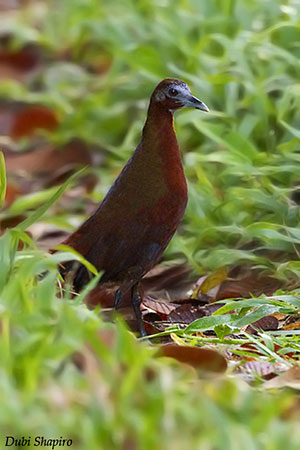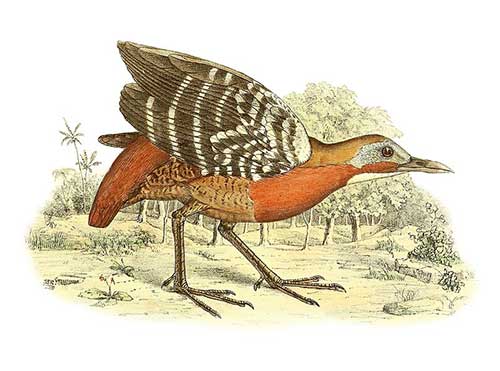
REPRODUCTION OF THIS SPECIES:
The laying occurs in May-June and September-November, and perhaps all year round. The race “berliozi” breeds in November.
The Madagascan Wood Rail builds a bowl-shaped structure with grass, ferns and leaves, about 2-3 metres above the ground, usually in bush or among lianas.
The female lays 2 pinkish-white eggs with sparse speckling and dotting. The downy chicks have black head and upperparts with light rufous-brown stripe on sides of back and rump. Forehead, supercilium, ear-coverts, throat and neck sides are rufous-brown. The underparts are rufous-brown. The brown down of head, neck and upperparts is tipped black, giving mottled pattern. The bill is grey-black with whitish tip.
PROTECTION / THREATS / STATUS:
The Madagascan Wood Rail is vulnerable to habitat destruction through continuous deforestation, but it is widespread throughout the range. The nominate race is currently fairly common.
The race “berliozi” appears still fairly common in Sambirano, but forest habitats are heavily threatened. This race should be regarded as Near Threatened due to habitat destruction.
The population is roughly estimated to number 670/1,300 mature individuals and is suspected to be declining.
But currently, the Madagascan Wood Rail is evaluated as Least Concern.
Fr: Râle à gorge blanche
Ang: Madagascan Wood Rail
All: Graukehlralle
Esp: Rascón Kioloide
Ita: Rallo del Madagascar
Nd: Madagaskargrijskeelral
Sd: madagaskarskogsrall
Mal: Tsikoza-ala
Photographer:
Dubi Shapiro
Dubi Shapiro Photo Galleries & Dubi Shapiro's Pictures on IBC
Illustrator:
John Gerrard Keulemans (1842-1912)
Illustration’s origin:
Recherches sur la faune de Madagascar et de ses dépendances d'après les découvertes de François P.L. Pollen et D.C. van Dam
Text by Nicole Bouglouan
Sources:
HANDBOOK OF THE BIRDS OF THE WORLD Vol 3 by Josep del Hoyo-Andrew Elliott-Jordi Sargatal - Lynx Edicions - ISBN: 8487334202
Birds of Madagascar and the Indian Ocean Islands Par Roger Safford, Adrian Skerrett, Frank Hawkins – ISBN: 1472924118, 9781472924117- Editeur: Bloomsbury Publishing, 2015
The Birds of Africa: Volume VIII: The Malagasy Region: Madagascar, Seychelles, Comoros, Mascarenes - Par Roger Safford, Frank Hawkins – ISBN: 1408190494, 9781408190494- Editeur: A&C Black, 2013
Rails: A Guide to Rails, Crakes, Gallinules and Coots of the World – By Barry taylor – Illustration by Ber van Perlo – ISBN: 1408135388, 9781408135389 – Editeur: Bloomsbury Publishing, 2010
Madagascan Wood rail
Canirallus kioloides
Ordre des Gruiformes – Famille des Sarothruridae
INTRODUCTION:
The Madagascan Wood Rail is endemic to Madagascar where it occurs in the eastern undisturbed rainforest. It is a large, rufous-brown rail with black natal down patterned with rufous-brown, regarded as primitive character in the Family Rallidae. Canirallus is a primitive genus now placed in the family Sarothruridae.
Two subspecies share the range, but the nominate race is widespread in the eastern rainforest, whereas the race “berliozi” is restricted to NW.
The Madagascan Wood Rail is vulnerable to habitat destruction, but the nominate race is not globally threatened. However, the race “berliozi” should be considered Near Threatened.
DESCRIPTION OF THE BIRD:
Biometrics:
Length: 28 cm
Weight: 258-280 g
The Madagascan Wood Rail has olive-brown crown to back, and chestnut lower back to tail. On the upperwings, the wing-coverts are olive-brown washed chestnut, except the lesser wing-coverts that are chestnut. The primary coverts and the primary and secondary flight-feathers are blackish with white barring on inner webs.
On the underparts, chin and throat are white and usually bordered by black spots. Neck, breast and upper belly are chestnut, and rest of underparts is dark brown with whitish to rufous barring. The undertail-coverts are dark.
On the head, the plumage is grey on forehead, around the eye and on ear-coverts. Crown and nape are chestnut. The lores may appear paler, mostly white rather than grey.
The bill is blackish with blue-grey tip and cutting edge. The eyes are dark brown. Legs and feet are reddish-brown.
Male and female are similar, although bill and legs are slightly longer in male.

The juvenile has washed chestnut to tawny upperparts. The chestnut underparts are mottled dull brown. The vent is barred buff to rufous.
The immature is duller than adults. It has less grey on the head. The undertail-coverts are spotted yellowish.
SUBSPECIES AND RANGE:
The Madagascan Wood Rail has two subspecies.
C.k. kioloides (described above) occurs in the eastern half of Madagascar.
C.k. berliozi occurs in Sambirano, in NW Madagascar.
This race is slightly larger and paler than nominate, with more extensive grey on forehead and white on throat. The mantle is more olive-green, whereas the belly is barred pale grey-green and brownish.
HABITAT:
The Madagascan Wood Rail usually occurs in undisturbed rainforest, but also in adjacent slightly degraded secondary growths with sparse herbaceous ground cover, and at the edge of ponds and woodland streams. It occurs from sea-level to 1,550 metres of elevation.
The race “berliozi” occurs from lowland transitional humid/dry deciduous forest, but it can be seen up to 1,240 metres of elevation.
CALLS AND SONGS: SOUNDS BY XENO-CANTO
The Madagascan Wood Rail is rather vocal. The common call is a series of loud, piercing whistles with rising inflexion “chuchuchuchuchuchuchu…” and variants “pyupyupyupyupyupyu…” lasting up to 30 seconds.
We can also hear various shorter notes, metallic, clinking, clucking and guttural mewing. The alarm call is a repeated, sneezing “tsik” or “chilyik”.
BEHAVIOUR IN THE WILD:
The Madagascan Wood Rail feeds on insects, amphibians, worms, snails and seeds.
It usually forages in pairs. The bird walk on the forest floor while bobbing the head and flicking the tail. It may also run swiftly through the undergrowth, stopping abruptly, probing the leaf litter, moving on and sometimes returning to the same area.
The Madagascan Wood Rail is territorial and apparently monogamous. The breeding behaviour is not described. The birds are in breeding condition in October. They are often seen in pairs.
The species is sedentary on the island, with no recorded movements.
The Madagascan Wood Rail prefers to run to escape a danger. It flies only in extreme danger, flying up to perch in tree or shrub. It is also recorded in trees to reach the nest usually placed a few metres above the ground.

John Gerrard Keulemans
(1842-1912)